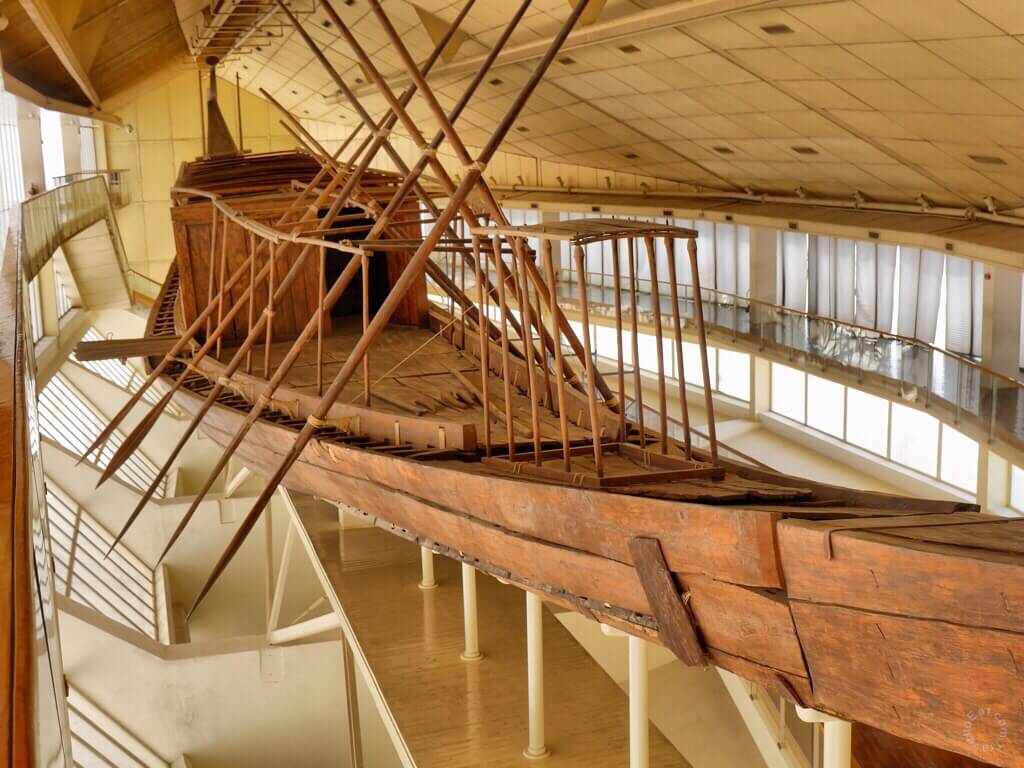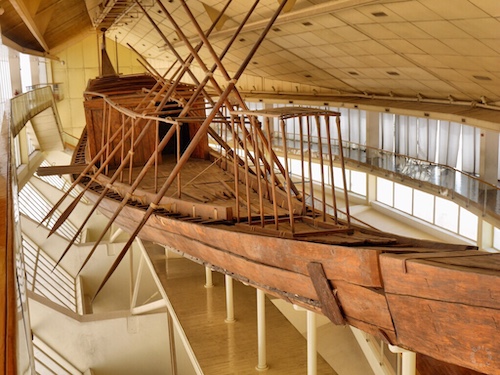
The Khufu ship is an intact full-size vessel from Ancient Egypt that was sealed into a pit in the Giza pyramid complex at the foot of the Great Pyramid of Giza around 2500 BC. The ship now is preserved in the Giza Solar Boat Museum. The ship was almost certainly built for Khufu (King Cheops), the second pharaoh of the Fourth Dynasty of the Old Kingdom of Egypt. Like other buried Ancient Egyptian ships, it was apparently part of the extensive grave goods intended for use in the afterlife, and contained no bodies, unlike northern European ship burials. The Khufu ship has been on display to the public in a specially built museum at the Giza pyramid complex since 1982. The ship was one of two discovered in 1954 by Kamal el-Mallakh, undisturbed since it was sealed into a pit carved out of the Giza bedrock. It was built largely of Lebanon cedar planking in the “shell-first” construction technique, possibly using unpegged tenons of Christ's Thorn. The ship was built with a flat bottom composed of several planks, but no actual keel, with the planks and frames lashed together with Halfah grass, and has been reconstructed from 1,224 pieces which had been laid in a logical, disassembled order in the pit beside the pyramid.
The Discovery

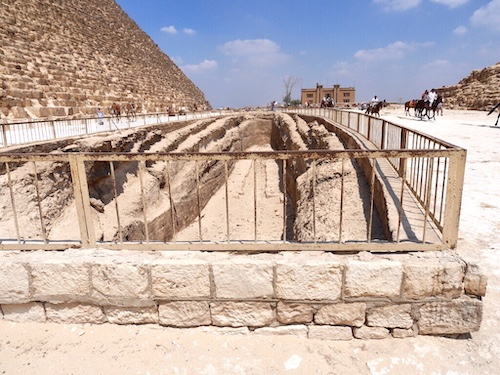
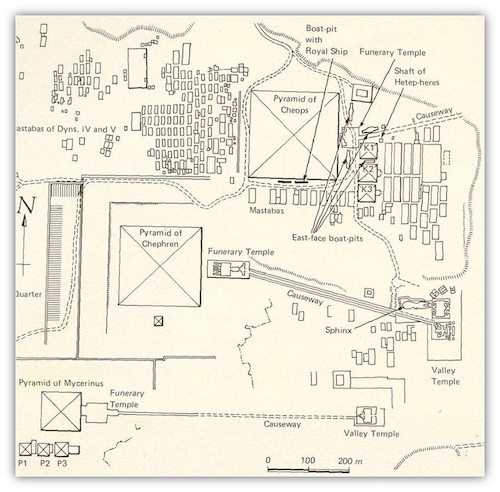
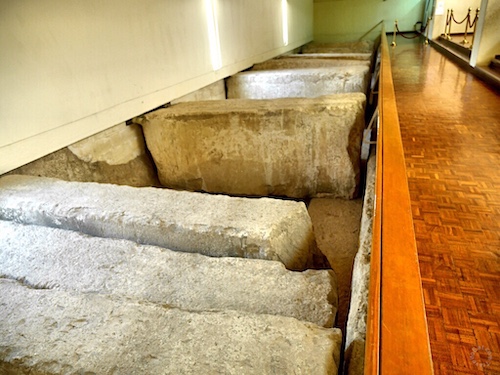
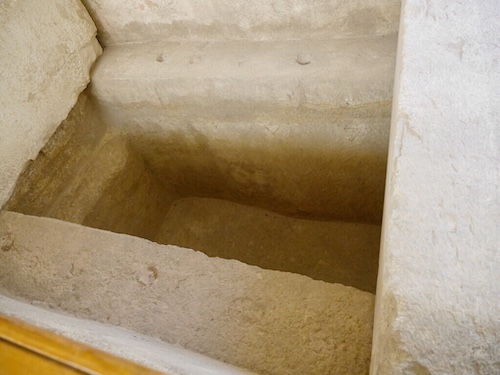
Seven boat pits have been identified around the Great Pyramid. Five of which belong to the Great Pyramid proper. Khufu's boat pits are located on the eastern side of the pyramid and the southern side. The other 2 are associated with the pyramid of Hetepheres (GIa) and the pyramid of the Ka (GId). The Khufu ship is housed in the Khufu Boat Museum, a small modern (and air conditioned) facility resting alongside the Great Pyramid. The first floor of the museum takes the visitor through visuals, photographs and writings on the process of excavating and restoring the ship. The ditch where the main felucca was found is incorporated into the museum ground floor design. The boat trench was covered with large and heavy limestone slabs.
Wood in Ancient Egypt
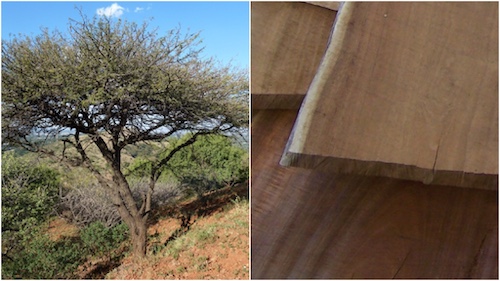
As good-quality wood is scarce in Egypt, wooden objects were often made up of many small pieces of wood. In the case of larger boats or boats for prestigious owners like the Pharoah, longer pieces of ceder were imported from Lebanon. During the occupation of Syria under Thutmose III the Egyptians exploited the mountain forests to the fullest extent. Cedar (ash) was valued for its straightness, as was the red pine, mer. They were used for the construction of a major fleet. Carob (sesnejem), and uwan (perhaps juniper) were also extensively cut. The Egyptian soldiers did the felling, the local rulers were in charge of transporting the timber to the coast. The importance the Egyptians attributed to timber is reflected in the fact that its supply was one of the duties of the vizier. Both Acacia (Acacia sp.) and Sidder (Ziziphus spina-christi) woods were used in boat building, for smaller boats and dowels. Vachellia nilotica is widely known as Acacia nilotica, or the common names gum arabic tree, Egyptian thorn, Sant tree, Al-sant or prickly acacia. The species name nilotica was given by Linnaeus from this tree's best-known range along the Nile river. The tree's wood is very durable if water-seasoned and its uses include tool handles and lumber for boats.
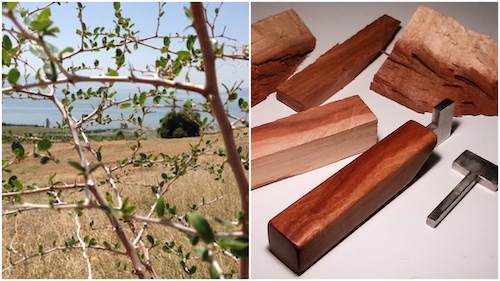
Christ's Thorn Jujube (Ziziphus spina-christi) derives both its common and scientific names from the belief by many that this tree provided the crown of thorns said to have been placed on Jesus' head before he was crucified. Throughout history, but especially in the Middle Ages, the tree was seen as sacred and was used for food. Today, in parts of its range it is still heavily used for a range of purposes, including its reputed medicinal properties. Wood from this tree is used for timber, wagon making and fence posts as it yields a yellow, fine-grained, heavy wood. Pliny made the following observations:
No less esteemed, too, in the same country, is a certain kind of thorn, though only the black variety, its wood being imperishable, in water even, a quality which renders it particularly valuable for making the sides of ships: on the other hand, the white kinds will rot very rapidly. It has sharp, prickly thorns on the leaves even, and bears its seeds in pods; they are employed for the same purposes as galls in the preparation of leather. It grows in the vicinity of Thebes…
Pliny, Natural History
Engineering
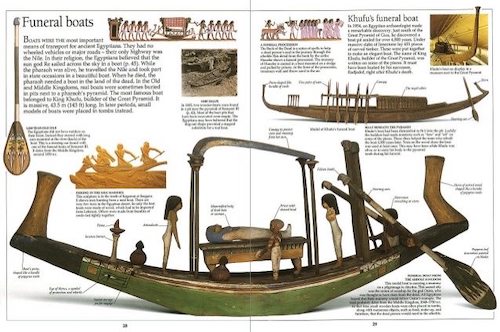
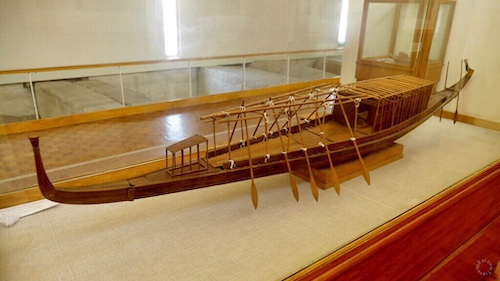
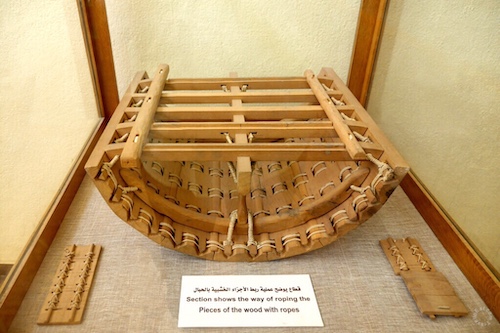


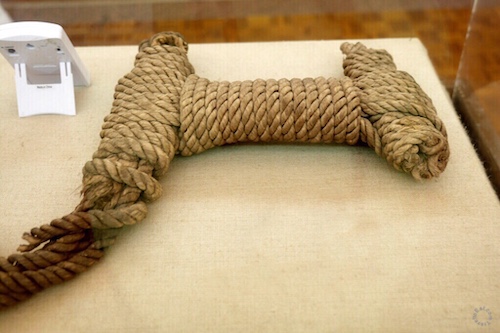

The Khufu ship was built with no nails, an amazing feat of engineering in itself. Along with the puzzle-piece “joggling”, its builders connected adjacent planks with mortise-and-tenon joints and/or wooden biscuits, a kind of peg-in-hole technique. The “biscuit” technique using a free tenon eventually became one of the most important features in Mediterranean and Egyptian shipbuilding and is still used today in furniture manufacture. They also lashed the hull planks together with rope made from a grass called halfa. You can see an original knot tied by pharaonic shipbuilders above. They didn't wrap the rope around or through the hull planks, which might have promoted leaks. Rather, they worked it through thousands of V-shaped channels they laboriously carved into the inside faces of planks. In essence, they sewed the ship together. All of this work was done with crude tools like the granite hammer seen above.
The Great Puzzle
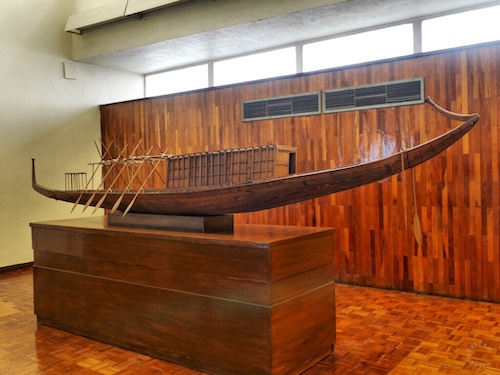
The cedar ship now on display was originally dismantled into 1,224 individual parts. On top of the wood was a layer of mats and ropes, an instrument made of flint, and some small pieces of white plaster. The prow of the boat, a wooden column topped by a round wooden disk, was found at the western end of the pit. This column was connected to two long wooden pieces that extended along the bottom of the pit. Most of the wooden parts had been tied together with ropes. Also found inside the pit were many other items, such as twelve oars, each made from a single piece of wood, fifty-eight poles, three cylindrical columns and five doors. In total, there were thirteen layers of materials consisting of 651 artifacts ranging in size from 10 centimeters to 23 meters. You can imagine the difficulty of reassembly of this many pieces with no idea of how the finished boat should look.
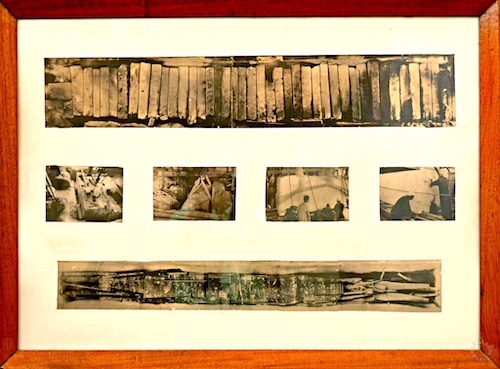


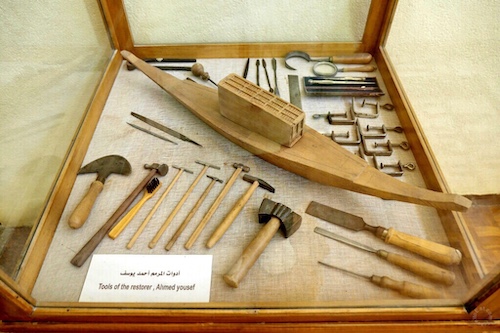
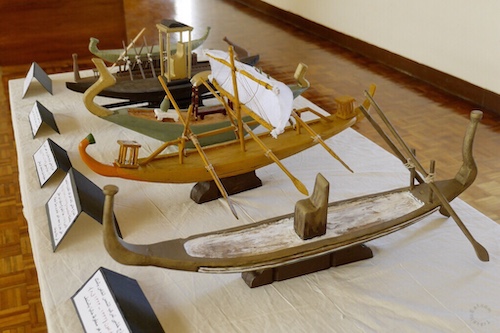
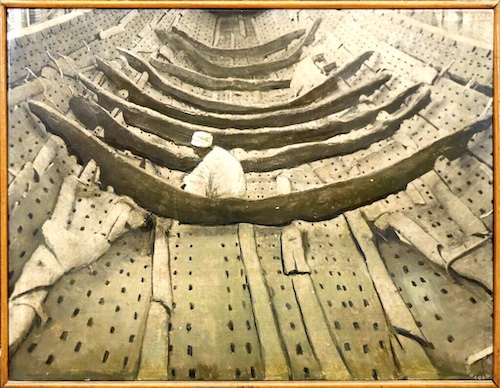
It took years for the boat to be painstakingly reassembled, primarily by the Egyptian Department of Antiquities' chief restorer, Ahmed Youssef Moustafa (later known as Haj Ahmed Youssef). Before reconstructing the boat, he had to aquire expertise on Ancient Egyptian boat-building. He studied the reliefs carved on walls and tombs, and many of little wooden models of ships and boats found in tombs. Hag Ahmed visited the Nile boatyards of Old Cairo and Maadi and went to Alexandria, where wooden river boats were still being made. He hoped that modern Egyptian shipwrights might have retained ship building methods that would suggest how Ancient Egyptians built their ships. Then he investigated the work of shipwrights who built in a different tradition. He made models to guide his studies which are shown above.
Khofu Ship on Display
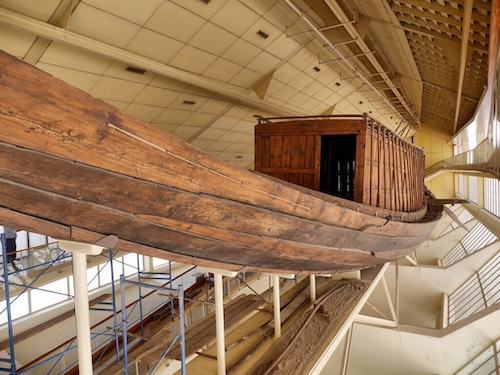
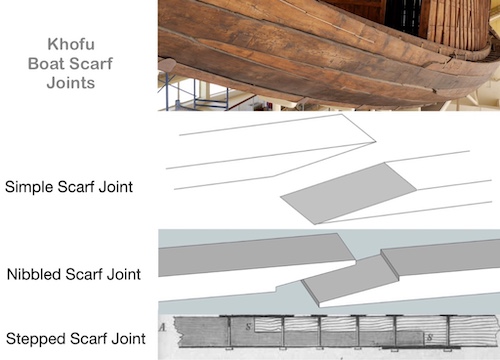
To see the restored ship, the visitor must climb a staircase leading to the second floor. Floor to ceiling windows allow for much sunlight and the wooden walkway takes the visitor around the barge where the visitor can get a close view of its impressive size: 143 feet long (44m) and 19.5 feet wide (6m). Boatbuilders today typically frame a vessel first, starting with the keel, then add the hull's planking. The Khufu ship was shell-built, meaning the outer skin of planks came first, then the interior timbers and framing. The workmanship is exceptional. The pharaoh's craftsmen shaped the ship's 30 hull planks from logs as long as 76 feet. They also sculpted the planks to follow the shape of the hull, and they “joggled” them along the edges, using “scarf” joints, seen today in bearing beams. You can see three different types of scarf joints, from the “Simple Scarf” to the “Nibbled Scarf” and finally the “S-Shaped” Scarf. Interestingly, the bearing load on the scarf joints used today is downward. Here the load is sideways against the joint, making the load characteristics of the joint hard to figure, perhaps explaining the differing approaches to the joint.
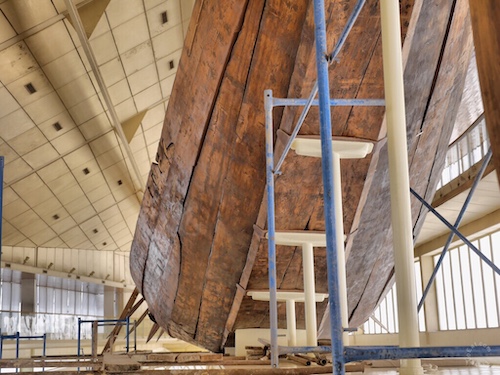
The Kufu ship has no keel, it does not have a heavy timber instead of a plank running along the longitudinal centerline of the hull bottom. That is, a skeleton of keel and ribs (more properly called frames) was not erected first, to which the hull planking was then fastened. In fact as far as we know, no Egyptian vessels had a keel until at least 1000 years later on. This approach allowed Egyptian boats used in trade to be easily disassembled, the planks transported long distances through the desert and then re-assembled to be used on important trading routes such as those in the Red Sea (see my post on the “Turin Papyrus Map”). The problem with this method of construction is “twisting” of the hull when out of water as seen in some of the Abydos boats from the late Second Dynasty (2675 BCE). However, as you can see, the bottom planking is slightly thicker than the side planking, acting as a kind of keel. Probably this boat never was immersed in water although that may be up for debate.
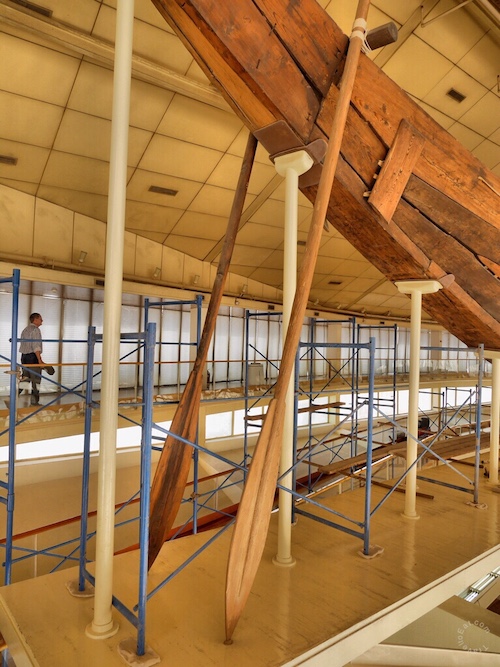
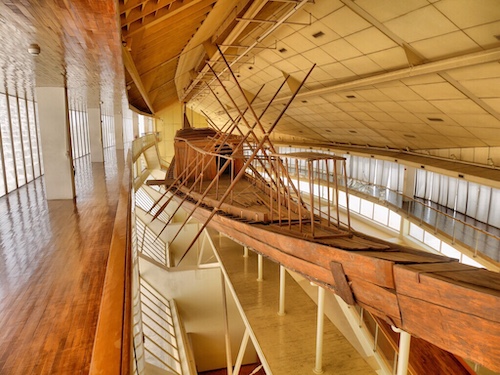
Each of the Khufu ship's 12 oars was carved from a single piece of wood, an extravagant waste of a precious Lebonese cedar. Ten oars are lashed amidships ahead of the deckhouse, though this positioning is arbitrary: where, or even whether, the oars were fixed is unknown. A final pair attaches to the stern as steering oars. Steering oars such as these appear in funerary carvings and paintings, and on ship models, right into the New Kingdom, a thousand years and more after Khufu's time. Apparently this boat was meant to be neither sailed (no sail) or paddled (no room) but instead was meant to be pulled like a barge. Hence the name “Solar Barge”.
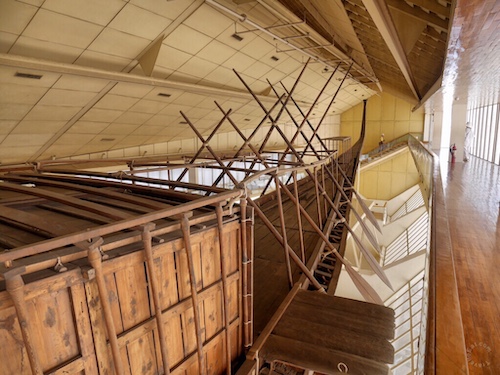
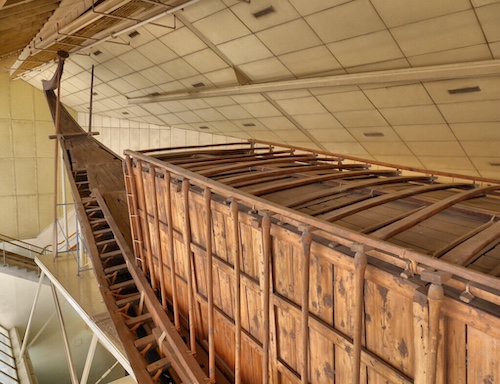
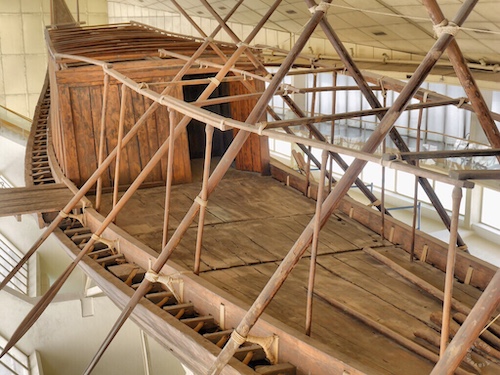

On the deck stands a roofed, windowless deckhouse about 30 feet long. Within it is a seven-foot-long inner chamber. Khufu's craftsmen appear to have designed the deckhouse for easy disassembly: The structure consists of 22 prefabricated, individually framed cedar panels. As seen here, a wooden framework extends out from the deckhouse. It might have held a mat or linen canopy, possibly for evaporative cooling, moistening the covering would have created an insulated cooler space within. In the ship's prow stood a second, wood-framed canopy. As with everything else regarding the ship's function, the intended use of these structures remains unknown.
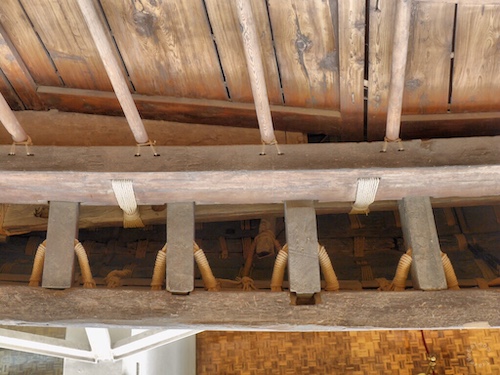
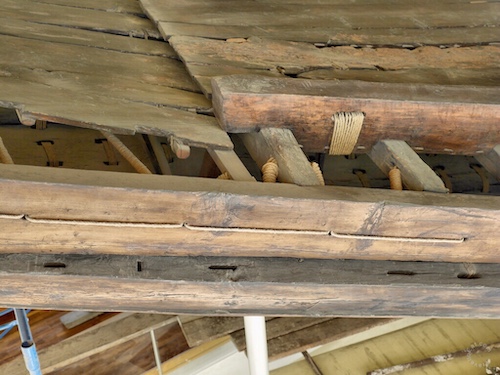
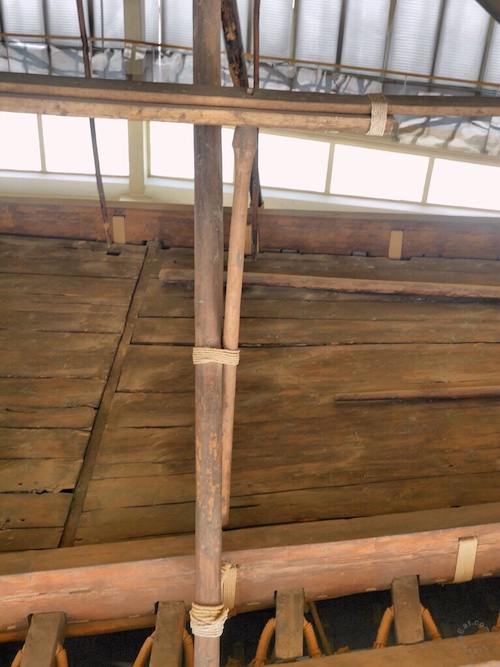
The ship is almost fully decked within the area bounded by the stringers, the curved timbers seen here on the inside of the outside hull. The decking itself consists of panels of mortise-and-tenon-joined planks. The smooth deck, smartly bounded by the stringers reminds me of the deck of a multimillion dollar yacht today, which is exactly what it was 5500 years ago. The cost of the Cedar, the labor and the refined design would easily translate to the best boat of it's age.
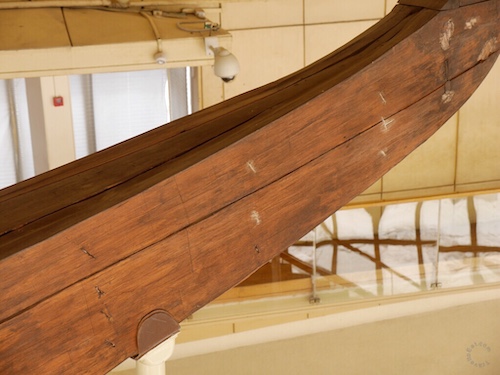
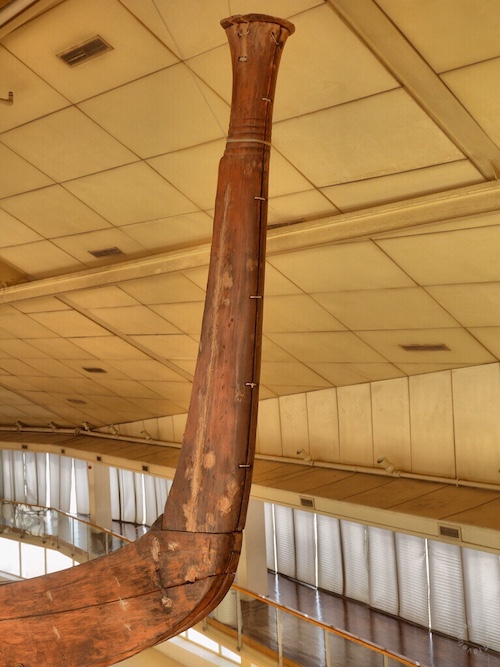
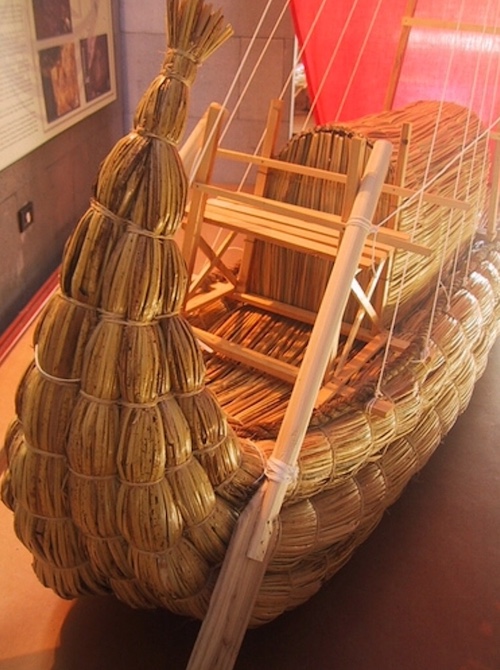
The “fit and finish” of the recomposed barge is nothing short of a monument to Ancient Egyptian woodworking and engineering art. The huge structure is built as carefully as a fine piece of furniture. The Khufu ship is known as a papyriform vessel, because the high ends resemble those of ancient papyrus boats. The turned columns, the elegant stem and stern evoking papyrus boats of antiquity, the fine decks and the enormous size all contribute to the monumental nature of this piece of art. Over a half century after the boat's discovery, scholars still debate its purpose. Some say the vessel is a solar barque or barge, which Khufu would have used in his persona as the sun god Re during his daily voyages across the sky. Others feel the ship was a funerary craft for transporting Khufu's body on the Nile to the Giza necropolis or on a final pilgrimage to holy sites. We may never know for sure but we can marvel at a truly unique achievement of the Ancient Egyptians. Leave a comment and let me know what you think.
[mappress mapid=”144″]
References:
Wood in Ancient Egypt: http://www.reshafim.org.il/ad/egypt/timelines/topics/wood.htm
Chist's Thorn Tree: http://www.reshafim.org.il/ad/egypt/botany/acacia.htm
PBS: http://www.pbs.org/wgbh/nova/pharaoh/expl-nf.html
Khufu Ship: http://nautarch.tamu.edu/class/316/khufu/
Funeral Boats: http://www.slideshare.net/mobile/carinaantuneslobo/eyewitness-books-pyramid
Tour Egypt: http://m.touregypt.net/featurestories/greatpyramid5.htm
Maritime History: http://maritimehistorypodcast.com/ep-006-khufus-solar-ship-sailing-afterlife/
The Boat Beneath the Pyramids: http://www.gizapyramids.org/static/pdf%20library/jenkins_boat.pdf
Turin Papyrus Map: /the-turin-papyrus-map-gold-myrrh-and-punt/

